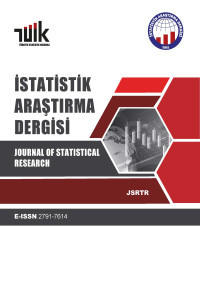Türkiye'de Hanehalkı Yoksulluğunu Etkileyen Faktörlerin Belirlenmesi
21. yüzyılda günümüzün en önemli sorunlarından biri olarak hayatımızda olan yoksulluk olgusu, ferdin hayatı üzerinde farklı derecelerde de olsa etkisini sürdürmektedir. Bu nedenle, yoksullukla mücadele için yoksulluğa neden olan etmenlerin bilinmesi önem teşkil etmektedir. Bu çalışmada amaç hanehalkı yoksulluğunu etkileyen faktörleri tespit etmek ve ANOVA aracılığıyla bunların söz konusu yoksul hanelerin kullanılabilir gelirleri üzerindeki etkilerinin büyüklüğünü tahmin etmek ve belirlemektir. Bu amaçla çalışmada Türkiye İstatistik Kurumu tarafından üretilmiş olan Gelir ve Yaşam Koşulları Araştırması’na ait olan 2016 yılı verileri kullanılmıştır. Hanehalkı yoksulluğuna etki eden faktörlerin belirlenmesinde ANOVA kullanılmıştır ve veriler SPSS programıyla analiz edilmiştir.
Anahtar Kelimeler:
ANOVA, Gelir ve Yaşam Koşulları Araştırması, Yoksulluk
Determination of Factors Affecting Household Poverty in Turkey
In the 21st century, the phenomenon of poverty, which is one of the most important problems of today, continues to affect the life of the individual, even if in different levels. Therefore, in order to struggle against poverty, it is important to know the factors that cause poverty. The aim of this study is to determine the factors affecting household poverty and to estimate and determine the magnitude of the effects of these factors on the disposable income of the poor households through ANOVA. In this context, 2016 Income and Living Conditions Survey data serviced by Turkish Statistical Institute (TurkStat) were used in this study. In order to determine the factors effecting household poverty, ANOVA was applied, and analyzed with the SPSS program.
Keywords:
ANOVA, Poverty, Study of Income and Living Conditions,
___
- Arabacı, R. (2016). Göreli Yoksulluk Yaklaşımı Ve Türkiye İçin Uygunluğu. Ataturk University Journal of Economics & Administrative Sciences, 30(5).
- Aksan, G. (2012). Yoksulluk ve Yoksulluk Kültürünün Toplumsal Görünümleri. Selçuk Üniversitesi Sosyal Bilimler Enstitüsü Dergisi, (27), 9.
- Aktan, C., C., ve Vural, İ., Y. (2002). “Yoksulluk: Terminoloji, Temel Kavramlar ve Ölçüm Yöntemleri”, Yoksullukla Mücadele Stratejileri, Aktan, Coşkun Can (ed), Hak-İş Konfederasyonu Yayınları, Ankara.
- Arbia, G., & Pace, M. L. (2018). Testing inequality of opportunities in Italy using the ANOVA framework. Empirical Economics, 55(1), 297-322.
- Box, G. E., & Cox, D. R. (1964). An analysis of transformations. Journal of the Royal Statistical Society: Series B (Methodological), 26(2), 211-243.
- Castellano, R., & Punzo, G. (2012). The impact of territorial factors on the total non-response error in the European Union–Survey on Income and Living Condition (EU-SILC). Statistica, 72(2), 211-233.
- Coşkun, S., ve Tireli, M. (2008). “Avrupa Birliğinde Yoksullukla Mücadele Stratejileri ve Türkiye”.
- Evcim, N., Güneş, S., & Karaalp-Orhan, H. S. (2020). Türkiye'de Hanehalkı Göreli Yoksulluğunu Etkileyen Faktörler: Lojistik Regresyon Analizi. Sosyoekonomi, 28(43), 11-32.
- Foster, J.E. ve Shorrocks A.F. (1991). Subgroup-Consistent Poverty Indices. Econometrica, 59(3).
- Karcı, Z., ve Bayram, N. A. (2018). Maddi Yoksunluğu Etkileyen Değişkenlerin Lojistik Regresyon Analizi ile Belirlenmesi. Süleyman Demirel Üniversitesi İktisadi ve İdari Bilimler Fakültesi Dergisi, 23(3), 1039-1048.
- Montgomery, D. C., (1991). “Design and Analysis of Experiments”, (3rd Ed.), John Wiley Sons, 649 s.
- Myers, R. H., Montgomery, D. C., & Anderson-Cook, C. M., (2016), Response Surface Methodology: Process and Product Optimization Using Designed Experiments. John Wiley & Sons., Hoboken, New Jersey, 856 s.
- Nelson, P.R., (1983), A comparison of sample sizes for the analysis of means and the analysis of variance. Journal of Quality Technology, 15, 33-39.
- Ramig, P.R., (1983), Applications of the analysis of means. Journal of Quality Technology, 15, 19-25.
- Rangaswamy, R., (1995), A textbook of agricultural statistics. New Age International, 552, New Delhi.
- Ravallion, M., & Datt, G., (1994), How Important to India's Poor is the Urban-Rural Composition of Growth? Policy Research Working Paper 1399, 1-25.
- Roscoe, J. T., (1975), Fundemental research statistics for the behavioral sciences. New York: Holt, Rinehart and Winston, Inc.
- Schiller, B. R., (2004), The Economics of Poverty and Discrimination, Pearson Prentice Hall, New Jersey.
- Sen, A. (1976). Poverty: An Ordinal Approach to Measurement. Econometrica, 44(2), 219-231.
- Şenses, F. (2002); Küreselleşmenin Öteki Yüzü: Yoksulluk, 2. Baskı, İletişim Yayınları, İstanbul.
- Taş, H. Y., ve Özcan, S. (2012). Türkiye’de ve Dünya’da yoksulluk üzerine bir araştırma. In International Conference on Eurasian Economies (pp. 423-430).
- TÜİK., (2008), Tüketim Harcamaları, Yoksulluk ve Gelir Dağılımı. Sorularla Resmi İstatistikler Dizisi 6. Ankara, Türkiye İstatistik Kurumu.
- TÜİK., (2016), Gelir ve Yaşam Koşulları İstatistikleri El Kitabı. Ankara, Türkiye İstatistik Kurumu.
- TÜİK., (2016), Gelir ve Yaşam Koşulları Araştırması.
- Ünver, Ş., & Alkan, Ö. (2020). Türkiye’de Bireylerin Maddi Yoksunluk Durumlarını Etkileyen Faktörlerin Modellenmesi. Business & Management Studies: An International Journal, 8(2), 1334-1370.
- Yaşar, S., & Taşar, M. O. (2019). Kavramsal Olarak Yoksulluk Ve Türkiye’de Yoksullukla Mücadele Politikalarının Etkileri. Sosyal Ekonomik Araştırmalar Dergisi, 19(38), 118-144.
- Yüce, M. ve Özbek,M.F. (2006). “Orta Asya Türk Cumhuriyetlerinde Sosyo-Ekonomik Boyutlarıyla Yoksulluk Olgusu Üzerine Bir Değerlendirme” , İktisat ve Girişimcilik Üniversitesi, Türk Dünyası Kırgız, Türk Sosyal Bilimler Enstitüsü Celalabat, Kırgızistan, Uluslararası Hakemli Sosyal Bilimler E-Dergisi, (100).
- ISSN: 1303-6319
- Başlangıç: 2002
- Yayıncı: TÜİK
Sayıdaki Diğer Makaleler
Kantil Regresyon Modellerinde Uyum İyiliği Ölçüleri ve Model Seçimi
Türkiye’de Toplumsal Cinsiyetin Çok Boyutlu Ölçekleme ile İncelenmesi
Türkiye'deki Nüfus Artışı ve Nüfus Projeksiyonlarının Ekonometrik Analizi
Türkiye'de Hanehalkı Yoksulluğunu Etkileyen Faktörlerin Belirlenmesi
